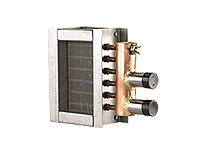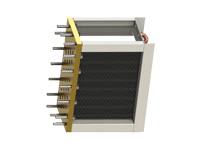
FAQs
MAKING BUSINESS EASY!
Q. How can I tell if the heating or cooling coil needs to be repaired or replaced?
A. It’s a good idea to check your coils before the heating and cooling season —especially if the coils are located near the
outside air inlet dampers A number of seemingly small items can lead to inefficiencies in the system and create havoc on
the coils.
-
Are the dampers sticking? This happens more often than you think. Preheat coils can easily freeze as a result of dampers not closing properly.
-
Are the freeze stats working properly? First, check to see that the freeze stat is properly located and that it is securely mounted on the coil end return.
-
Inspect the freeze stat connections making sure they are free of corrosion.
-
How do the coils look? They must be free of debris in and around the fins otherwise problems will occur. On a cooling coil, check for evidence of moisture carryover beyond the drain pan from the coil and that there are no visual signs of microbial growth.
-
Are the fins showing signs of deterioration? If so, and are compromised to the point where loss of heat transfer is severe (on a preheat coil) chances of freezing the coils downstream are greatly enhanced.
-
Check the steam traps. Do any of the components need to be serviced or replaced?
-
Are there signs of microbial growth in the drain pan or drain line? If there are, clean both and check the system frequently as that could be a sign of other things going on in the system.
-
Do you see standing water? Check the floor around the air handling unit. If leaking coils are the cause – call us!
-
What do you hear? Listen to your steam coils… listen for that tick—tick—tick inside the AHU. That ticking sound is a sure sign that water hammer is present and may not only lead to a premature failure of the coil and loss of capacity, but also to potential freeze-ups of coils downstream. Causes of water hammer include:
-
Is the steam filling the inner tube? Make sure that the steam fills the inner tube with enough force to drive the condensate out of the coil. If it is not, chances are the coil has not been correctly designed for the system.
FOR COIL QUESTIONS, CALL THE EXPERTS AT MAIOCCO AND ASSOCIATES, INC.
Q. What is the hand?
A. When designing coils for a specific system, we frequently refer to "the hand of the coil".
What we are asking is if it is a left hand coil or right hand coil. To determine the hand of the coil:
-
Face the coil so the air is hitting you in the back of the head.
-
Check the location of the pipe connections.
-
If the pipe connections are on the right side, then you are looking at a right hand coil and vice versa.
Q. Why is it important to determine the hand of the coil in a cooling coil?
A. The goal is to achieve the greatest temperature differential between the entering air and the cooling medium as possible — and accomplish this with efficiency. Knowing the hand of the coil allows you to make sure the air and the cooling medium are moving in opposite directions giving you the greatest opportunity for temperature difference.
Q. How to I determine the circuitry of a coil?
A. Knowing the number of tubes in one row vs. how many tubes in that same row are being fed from the supply header will give you the circuitry. For example:
Full Circuit Coil
Half Cicuit Coil
Quarter Circuit Coil
Double Cicuit Coil
20 tubes in a row (20 tubes are fed from the supply header)
20 tubes in a row (10 tubes are fed from the supply header)
20 tubes in a row (5 tubes are fed from the supply header)
20 tubes in 1st row | 20 tubes in 2nd row (all tubes in both rows are fed from the supply header)
Q. What is the relationship between fluid velocity and air velocity when it comes to heating and cooling coils?
A. The faster the fluid velocity, the higher the coil capacity, however, the higher the air velocity, the lower the coil capacity. Care must be taken when selecting replacement coils to ensure that the new coil velocities matches the coil being replaced. It is important to have the original design data (when available) to ensure that the capacity will be as close to what was intended.
Q. What effect does air velocity have on pressure drop?
A. Fans are selected for their ability to deliver a specific volume of air at a given pressure drop (resistance). One of the components considered in the calculation of the overall system pressure drop is the coil. When specifying a replacement coil, it is critical that the new coil will not significantly increase the pressure drop. Simply stated, if the coil surface area is reduced (resulting in higher air velocities) or the silhouette of the fin is increased (higher corrugation), the pressure drop may increase to a point where the fan can no longer overcome the static resistance that the fan was originally designed to handle. This can result in a drastic reduction of performance, higher leaving air temperatures in a cooling coil and lower air temperatures in a heating coil.
Q. What is moisture carryover?
A. In a cooling coil application, moisture carryover (or sometimes called water blow off) happens when the air velocity is too high creating the potential for water that has condensed on the surface of the cooling coil to blow off and travel down the airstream. Excessive moisture in the airstream can cause a whole host of unwanted water related issues. As a general rule, try to avoid air velocities over 500 fpm. In some cases, coated coils can produce blow off in velocities under 500 feet per minute. To maximize performance and minimize problems, consult with Maiocco & Associates when it comes to designing or replacing your coils.
Q. What should be considered when selecting material gauges for heating and cooling coils and heat exchangers?
A. When selecting material gauges, the biggest consideration is the ability of a coil to withstand the rigorous cleanings performed by pressurized air and water. These cleanings can wear down the materials over time. The maintenance and cleaning schedule required for the heat transfer equipment for the system should be a high consideration for the new or replacement heat transfer equipment purchased.
When selecting tube wall thickness, a thinner tube wall reduces the landed surface of the "tube to header joint". Luvata/Heatcraft manufactures their line of heat exchangers with the tube intruding into the header prior to brazing at a measurement of 2 ½ times the tube wall thickness. This increases the landed surface to be brazed to the header.
The result is more dependable, longer lasting joints between the header and the tubes, and between the tubes and return bends that are less susceptible to premature failure.
Tube wall thickness is also a consideration for shell and tube heat exchangers. In most cases the tubes are expanded to the tubes sheet, (not brazed), and the thicker tube wall results in a stronger bond yielding a longer life.
-
How can I tell if the heating or cooling coil needs to be repaired or replaced?
-
Why is it important to determine the hand of the coil in a cooling coil?
-
What should be considered when selecting material gauges for heating and cooling coils and heat exchangers?
-
Poor or inefficient trapping of the condensate
-
Insufficient drip leg off the condensate connection to the trap—minimum distance required 12”
-
No pitch built into the coil to promote positive condensate drainage, or piping that is not pitched properly for excessively long runs
-
Improper piping or lack of ancillary equipment that may deliver wet steam to the coil. Quickly check things like: Thermostatic air vents, Vacuum breakers, Compromised inner steam distributing tube.




